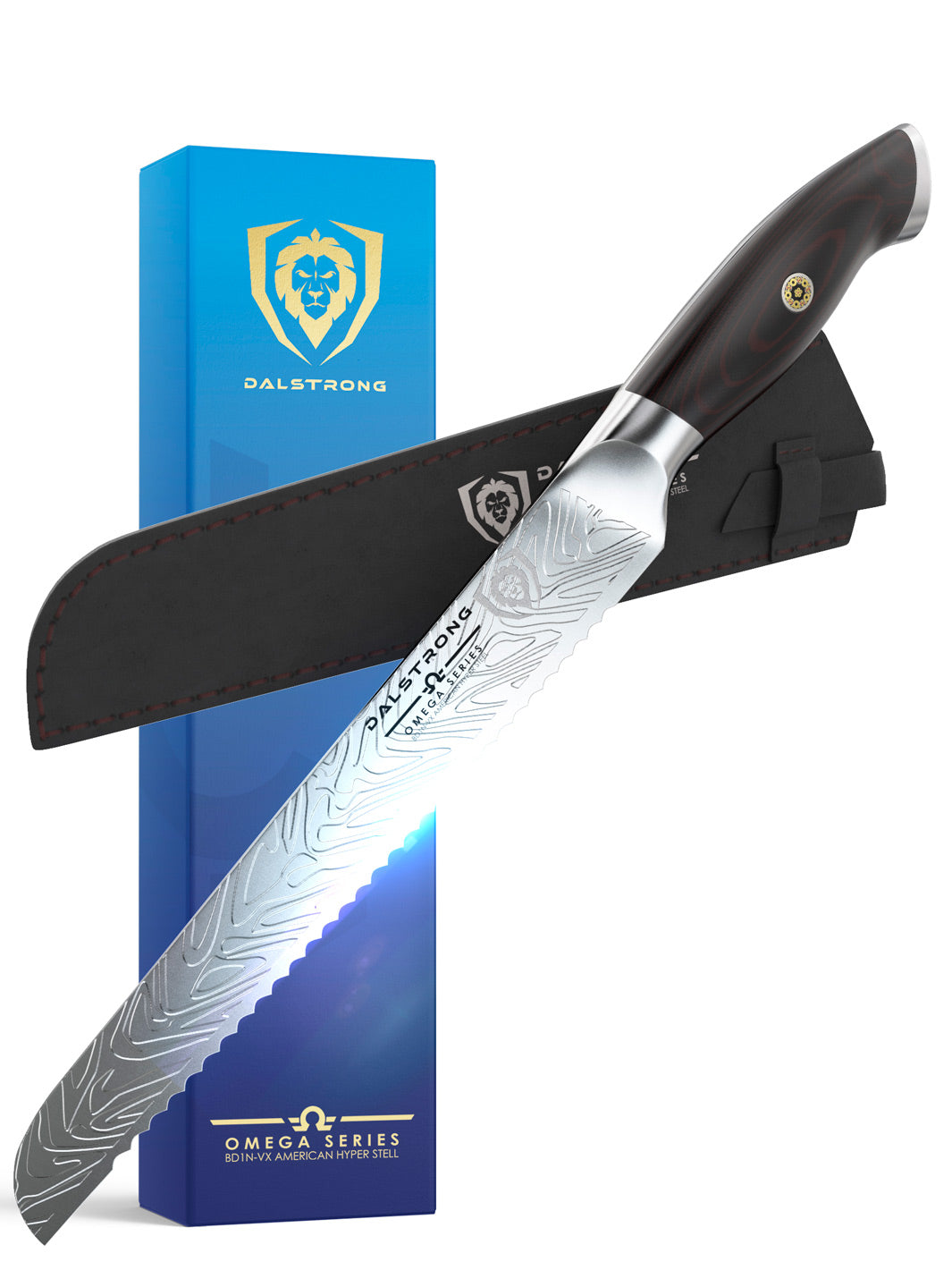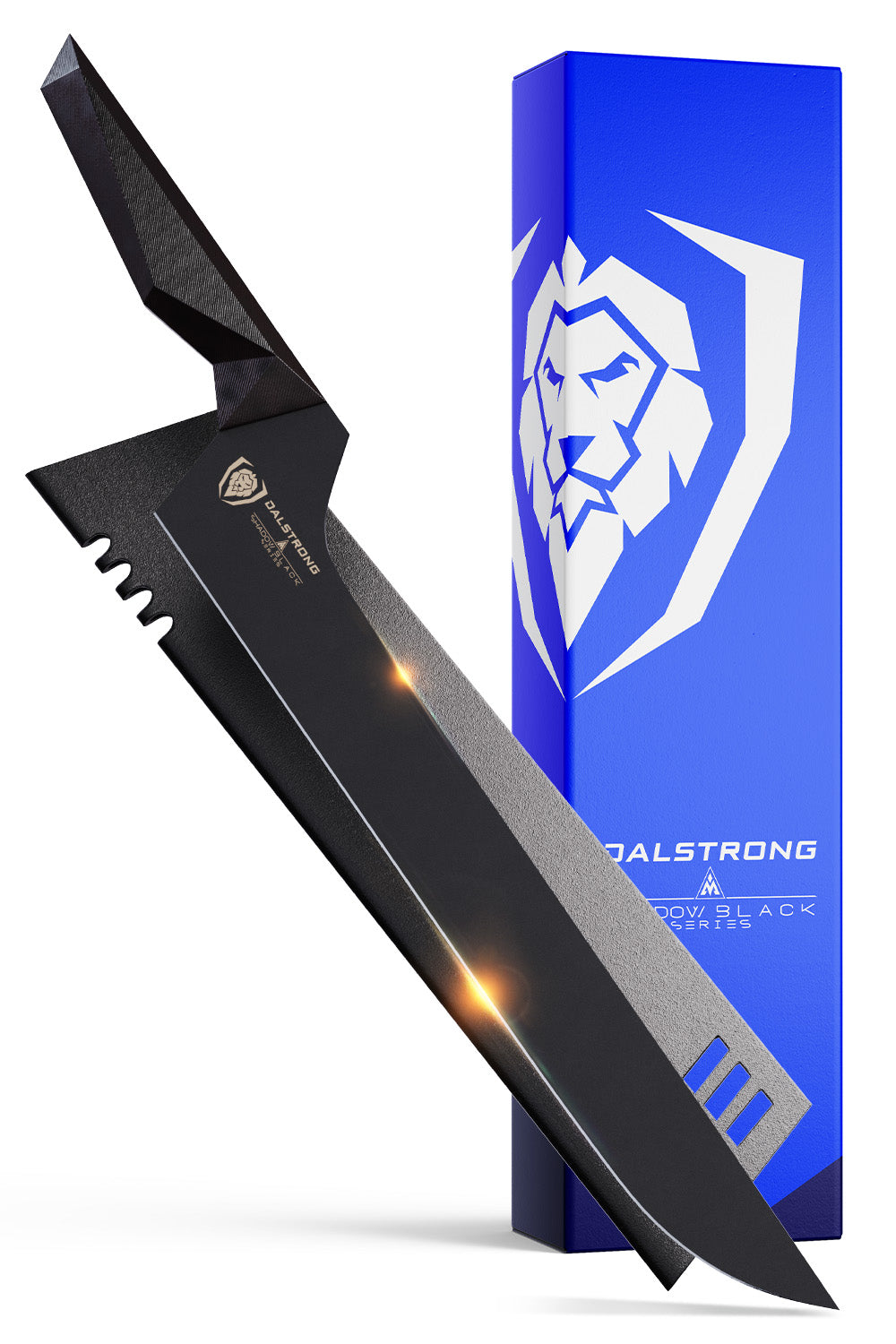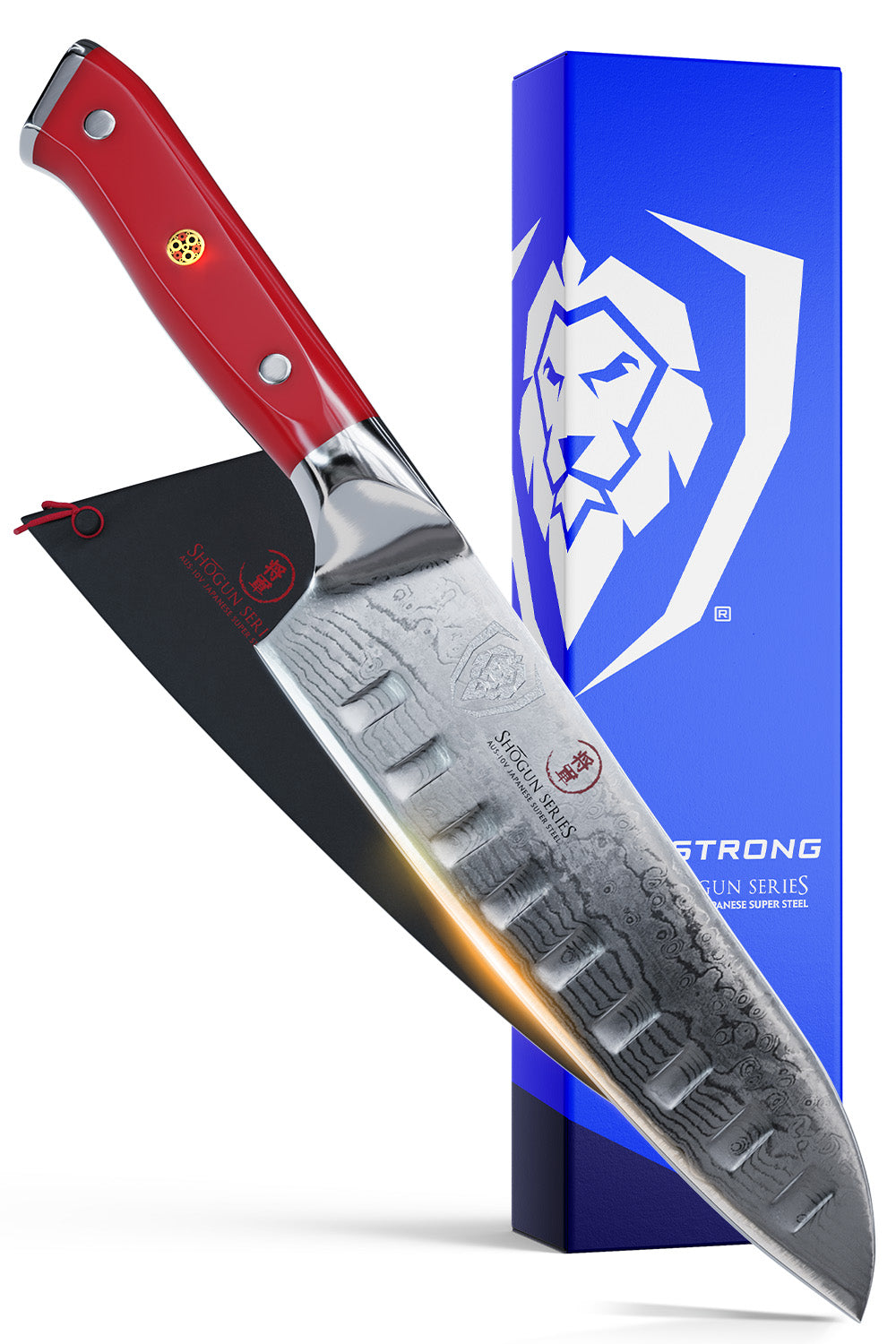
Ever looked at your kitchen drawer and wondered why knife shapes are so varied? Let's delve deep into the world of knife anatomy, from pocket knives to the mighty chef’s knife, and find out the mystery behind their shapes.
1. Why You Should Know Your Blade Types
 Chef's Knife 8" Shogun Series ELITE
Chef's Knife 8" Shogun Series ELITE
Embarking on the culinary journey is not just about the food. It's about the relationship you forge with your tools, akin to the bonds we create in our personal lives. Just as with dating, diving into the world of cooking can be an exhilarating blend of excitement, uncertainty, and discovery. You'll meet various kitchen tools along the way; some will be your perfect match, while others will serve as lessons.
Utilizing the wrong knife for the wrong purpose is something that you notice almost right away, because they're just not designed for that task. It becomes evident quite quickly that having a keen understanding of knife shapes, much like understanding what you want in a relationship, can be the difference between culinary bliss and frustration.
Why is it that one knife can elevate your confidence, making every slice feel like a masterpiece, reminiscent of a top-tier cooking show? As we delve deeper into the world of knives, we'll unpack these mysteries, ensuring your culinary journey is filled with more gourmet moments and fewer mishaps.
2. Why a Blade Shape Matters
 Fillet Knife 6" Frost Fire Series | NSF Certified | Dalstrong
Fillet Knife 6" Frost Fire Series | NSF Certified | Dalstrong
At first glance, a knife is just a knife, right? However, anyone who's been on the front lines of culinary battles or braved the wilderness will testify that not all knives are created equal. The blade shape is the unsung hero in the equation, significantly influencing how a knife performs in specific tasks.
Imagine the frustrating endeavor of trying to slice through a ripe tomato with a blade that's as dull as a rainy day. Or, picture the sheer absurdity of bringing a knife designed for thick jungles to thinly slice delicate sashimi. It's akin to using a sledgehammer to hang a picture frame – overkill, to say the least.
Purpose and precision
The shape of a blade, combined with its sharp edges, is purpose-driven. Certain blade shapes are optimized for precise cuts, while others are designed for more rugged tasks. A blade's design can influence its agility, its ability to maintain an edge, and even its strength in heavy-duty tasks.
Maintenance and longevity
Understanding a blade's shape also plays a pivotal role in knife maintenance. Specific shapes require particular care to preserve their cutting edges. A knife designed with a hollow grind, for instance, might need a different sharpening technique compared to one with a straight spine.
Safety and efficiency
Having the right knife blades for your task not only ensures that you achieve the desired results but also boosts safety. Using a knife shape not intended for a particular task can increase the risk of accidents, as you might apply inappropriate force or use incorrect cutting techniques. Moreover, using the right blade ensures the work feels less like a chore and more like a craft, making you efficient and confident in your cuts.
Storage and accessibility
Proper knife storage is just as crucial as having the right blade. Storing blade knives in a way that protects their unique shapes ensures longevity and maintains those sharp edges. Whether it's pocket knives, fixed blade knives, or your favorite chef's knife, storing them correctly preserves their integrity and keeps them ready for action.
3. The Five Main Kitchen Knife Shapes
Chef's Knife
Often termed the workhorse of the kitchen, the chef's knife usually sports a blade length of around 8 inches. But it's not the length alone that makes it special. The broad and slightly curved belly of the blade is intentionally designed this way. Why? The curve allows the chef to use a rocking motion when cutting, which ensures precision and efficiency.
This blade shape makes tasks like chopping herbs, mincing garlic, and dicing vegetables a breeze. Furthermore, the wide belly also helps in scooping up the chopped items and transferring them. When you see a chef's knife, think of versatility.
Here's a great example of a chef's knife:
Chef's Knife 8" | Shogun Series ELITE
An epitome of kitchen elegance, this is the blade every aspiring chef dreams of. A magnificent harmony of 66-layer Damascus embracing a Japanese Super Steel Core. The elongated, expansive blade facilitates both rock chop and push cut with unparalleled ease. Meanwhile, the tapered bolster elevates your control. And the exquisite hammered Tsuchime finish? That's your secret weapon against sticking slices.
PROS:
- Features an Aus10V Japanese Super Steel core, ensuring a blade that's not just sharp, but enduringly so.
- Also features a 66-layer Tsunami Rose Damascus blade pattern, making for a blend of robust strength and beauty.
- The Dalstrong D3 sharpening at 8-12° ensures rapid, smooth slicing every single time.
- Built with a military-grade G10 handle, you've got a knife that's set to last, come heat or high water.
CONS:
- This premium product might be on the upper end of the price range for beginners..
- The intricate Damascus pattern is not for everybody.
Paring Knife
If the chef's knife is the workhorse, the paring knife is the detailed artist of the culinary world. Typically 3 to 4 inches in length, it's nimble and precise. The straight edge and sharp tip allow for meticulous jobs. Need to de-seed a chili, peel an apple, or intricately design a fruit garnish? This is your go-to knife. Its small size offers control that larger knives can't, making it perfect for detail-oriented tasks.
Here's a great example of a paring knife:
Paring Knife 3.5" | Gladiator Series | Dalstrong

This paring knife's diminutive size and tapered point provide a mastery of detailed tasks. Whether you're looking to peel an apple, mince herbs, or create decorative garnishes, this tool is tailored for you. The knife is not just efficient but aesthetically pleasing, with a G-10 Garolite handle offering ergonomic comfort and military-grade durability.
PROS:
- Precision forged with high carbon German Steel, it promises sharpness and longevity at a staggering 56+ Rockwell hardness.
- A hand sharpened edge at 16-18° per side perfectly balances sharpness with resilience.
- Complete with a tall blade height, your knuckles get a lot of space, making chopping and prepping a breeze.
- The ergonomic G10 Garolite handle provides a blend of strength, finesse, and a grip that ensures the knife becomes an extension of your hand.
CONS:
- Due to its specialized design for precision tasks, it might not be the go-to knife for larger kitchen operations.
- The intricate design and materials may make it slightly intimidating for kitchen novices.
Bread Knife
One glance at a bread knife and you can tell what it's for. Those serrated edges aren’t just for show. Designed like a saw, the serrations break through tough crusts without squashing the softer interior. Whether it's a rustic baguette, a delicate croissant, or even a ripe tomato, the bread knife ensures the integrity of the item remains intact. The serrated design also means it stays sharp longer since the entire edge doesn't often come into contact with the cutting board.
Here's an awesome example of a bread knife:
Bread Knife 9" | Shadow Black Series | Dalstrong

Though traditionally designed for bread, this blade excels at cleanly cutting through anything from melons to delicate pastries. Its serrated edge means no crushed crusts and no mashed fillings. With a design that looks as menacing as it feels powerful, this knife isn't just a kitchen tool – it's a bold statement. The dark aesthetics and unique handle design juxtapose with its purpose, proving that even a knife meant for the softest bread can look fierce.
PROS:
- The serrated scalpel-like edge, hand-finished to 15° per side, ensures precision even on delicate foods.
- Enhanced with a titanium nitride coating, the blade provides improved robustness, corrosion resistance, and non-stick properties.
- Crafted from high-carbon 7CR17MOV-X super-steel, it guarantees amazing performance and prolonged edge retention.
- A uniquely designed ergonomic handle made from military-grade G10 ensures a firm grip and looks super cool.
CONS:
- The aggressive design might not be to everyone's taste.
- It might clash with your other knives.
Utility Knife
A Jack-of-all-trades in the knife world, the utility knife often has a blade length of between 4 to 7 inches. It serves as the bridge between the heft of a chef’s knife and the precision of a paring knife. It's your go-to blade for tasks that aren’t quite right for either of its cousins. Whether you're slicing sandwiches, cutting vegetables, or portioning meat, the utility knife has got you covered. Its versatility ensures it's never out of place in any kitchen.
Below is an awesome example of a utility knife:
Utility Knife 5" | Phantom Series | Dalstrong
This utility knife is the perfect marriage between the nimbleness of a paring knife and the heft of a chef's knife, making it a great tool in any kitchen. Its versatile nature shines through when handling a variety of tasks, from slicing and trimming to the intricate details of coring and peeling.
PROS:
- Made with premium Japanese AUS-8 steel, this blade ensures durability, sharpness, and stain resistance.
- Its ruthlessly sharp edge, hand-finished to a precise 13-15°, guarantees seamless and effortless cuts every single time.
- A perfect hybrid, the utility knife's size and design bridge the gap between a chef’s knife and a paring knife, catering to diverse culinary tasks.
- The handle, made from premium laminated pakkawood, not only provides superior strength but also looks amazing.
CONS:
- It's a kind of "in between" knife between the paring knife and the chef's knife; some home cooks would be better served by having one or the other.
- This knife might be a little heavier than expected by its size.
Santoku Knife
The word "Santoku" translates to "three virtues" and this knife certainly lives up to its name. It excels in three key areas: slicing, dicing, and chopping. Unlike the rounded belly of the chef's knife, the Santoku often has a flatter edge and a thinner blade. This allows for cleaner, quicker cuts. The blade also often has divots or "granton edges," which create tiny air pockets that prevent food from sticking to the blade. For those who favor an up-and-down chopping motion over rocking, the Santoku is a dream.
Check out this awesome Santoku knife:
Santoku Knife 7" | Valhalla Series | Dalstrong
This Santoku knife has a robust 5-layer high-carbon steel construction, meaning resilience even in the face of the toughest ingredients. Drawing inspiration from the fierce spirit of the Vikings, this 7" blade is the epitome of grace and grit, with a celestial resin handle that looks amazing. Whether you're a chef preparing a banquet for the gods or just looking for a reliable blade to navigate everyday kitchen challenges, this Santoku promises to be your best companion.
PROS:
- The 5-layer high-carbon steel construction ensures sharpness, durability, and resistance to wear and tear.
- It's extremely versatile, designed to handle slicing, dicing, and mincing with unparalleled ease.
- A hand-sharpened edge at 8-12° per side guarantees precise and clean cuts every single time.
- The celestial resin handle, reinforced with stabilized wood, is one of the coolest-looking knife handles you'll ever see.
CONS:
- Not everyone is going to be a fan of this knife's distinctive look, but that only makes it all the more special.
- For those unfamiliar with Santoku knives, there might be a slight learning curve.
4. Less Common Knife Shapes
 Cleaver 9" The Banshee | Phantom Series | Dalstrong
Cleaver 9" The Banshee | Phantom Series | Dalstrong
The culinary and outdoor worlds are teeming with many knife shapes, some renowned and others more obscure. While everyone might know the mainstream knife types, it's these lesser-known variants that often come with a rich history and specialized purposes. Let's take a closer look:
Buck knives
These are synonymous with the great outdoors. Buck knives are the go-to for many hunting enthusiasts. What sets them apart? It's primarily their clip point blade. This design, which narrows to a pointed tip, has excellent control, especially when making more detailed cuts or incisions. It's not just about aesthetics; the clip point blade ensures precision, whether you're skinning game or performing other intricate tasks.
Tanto blades
A blast from Japan's ancient past, Tanto blades were inspired by the legendary samurai swords. They stand out with their high point and flat grind, converging to form an exceedingly robust tip. This design makes them perfect for piercing hard materials. Modern-day uses? You'll find Tanto blades being the blade shape of choice in many tactical knives, ensuring strength and durability in high-pressure situations. If you want to know more about the Tanto blade, here's a useful article.
Wharncliffe and Sheepsfoot blades
At first glance, these might seem odd. But their uniqueness is their strength. Both blades boast a straight edge that runs almost parallel to the blade's spine. What’s the advantage? Exceptional slicing capability. And the blunt tip ensures you can slice and chop without the inherent risk of puncturing or accidentally stabbing, making them invaluable in settings where precision and safety go hand in hand.
Kukri Blade
An emblematic blade from the heart of Nepal, the Kukri boasts a distinct inwardly curved design. This isn't just for show; the shape lends itself to various tasks, from chopping wood to clearing brush. The curvature provides leverage, granting more force with each swing. Given its versatility, it's no wonder the Kukri has established itself as a staple survival knife for many.
Dagger Blade: Evoking images of cloaked figures in moonlit alleys, the dagger blade is as practical as it is iconic. Its symmetrical design showcases sharpened edges on both sides, culminating in a pointed tip. Its dual-edged sharpness makes it adept at piercing tasks. While it may seem like something out of folklore, the dagger blade remains relevant in tasks requiring precision and force in equal measure (for example, oyster shucking knives)
Read about how to care for your kitchen knives, here.
5. Knife Anatomy and Design
 Paring Knife 4" Valhalla Series | Dalstrong
Paring Knife 4" Valhalla Series | Dalstrong
What are some other variables that come into play in the vast world of knife shapes?
Fixed blade vs. folding knives
When it comes to pocket knives, there are primarily two categories: fixed blade and folding knives. Fixed blade knives, as the name suggests, have a blade that does not fold or retract into the handle. They often come with sheaths for safe storage. Folding knives, like the popular Benchmade Bugout or Spyderco Paramilitary, have a pivot point allowing them to fold into the handle, making them a great everyday carry choice.
Blade grinds
Beyond the blade shape, the grind of the knife is crucial. From hollow grinds that have a distinct concave feature on the blade to the straight spine that gives the knife a more uniform and flat look, understanding grinds can help you in knife maintenance. The edge grinds, for example, determine how the sharpened edge is formed.
Specialty blades
Let's not forget the self-defense realm. Tanto blades, with their strong tips, are common in tactical knives. Then we have hawkbill blades and trailing point blades, often associated with specific tasks like cutting ropes or slicing. For hunting aficionados, the gut hook blade is a design to consider. And for the traditionalists, the straight back knife remains a favorite.
6. Frequently Asked Questions
Why are knives shaped differently?
Knives are shaped differently to cater to specific tasks and purposes, ensuring optimal performance, safety, and efficiency in various settings. From the kitchen to the great outdoors, the blade shape determines the knife's ability to cut, slice, chop, or pierce effectively.
What shape is a chef's knife?
A chef's knife typically has a broad blade that tapers upwards to a point. This design, with its wide belly and usually 8-inch length, allows for a rocking motion ideal for mincing and chopping.
What is the strongest knife shape?
The Tanto blade is often regarded as one of the strongest knife shapes. Its high point with a flat grind leads to an extremely robust tip, making it particularly durable and adept at piercing hard materials.
What is the shape of a knife?
The shape of a knife refers to the configuration of its blade, encompassing its curvature, length, width, point, and edge design. This shape determines the knife's specific functions and its effectiveness in carrying out those tasks.












